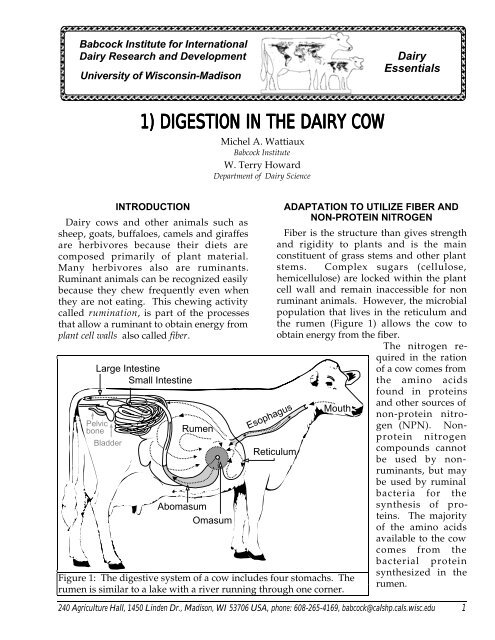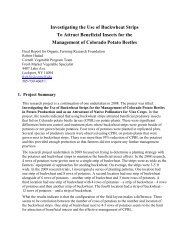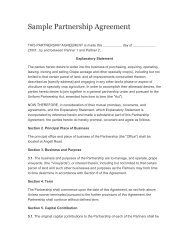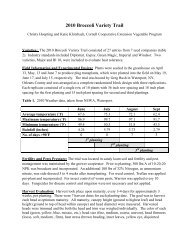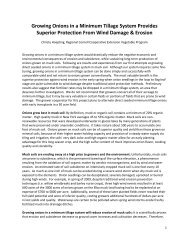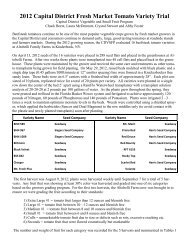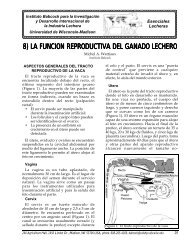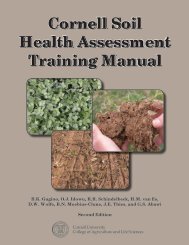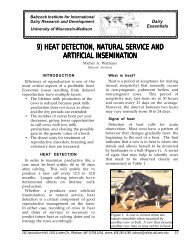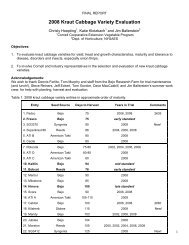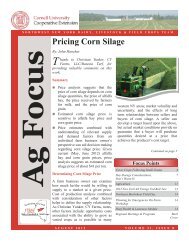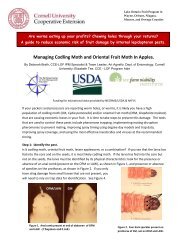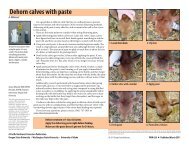1) digestion in the dairy cow - Babcock Institute - University of ...
1) digestion in the dairy cow - Babcock Institute - University of ...
1) digestion in the dairy cow - Babcock Institute - University of ...
- No tags were found...
You also want an ePaper? Increase the reach of your titles
YUMPU automatically turns print PDFs into web optimized ePapers that Google loves.
<strong>Babcock</strong> <strong>Institute</strong> for InternationalDairy Research and Development<strong>University</strong> <strong>of</strong> Wiscons<strong>in</strong>-MadisonDairyEssentials1) DIGESTION IN THE DAIRY COWMichel A. Wattiaux<strong>Babcock</strong> <strong>Institute</strong>W. Terry HowardDepartment <strong>of</strong> Dairy ScienceINTRODUCTIONDairy <strong>cow</strong>s and o<strong>the</strong>r animals such assheep, goats, buffaloes, camels and giraffesare herbivores because <strong>the</strong>ir diets arecomposed primarily <strong>of</strong> plant material.Many herbivores also are rum<strong>in</strong>ants.Rum<strong>in</strong>ant animals can be recognized easilybecause <strong>the</strong>y chew frequently even when<strong>the</strong>y are not eat<strong>in</strong>g. This chew<strong>in</strong>g activitycalled rum<strong>in</strong>ation, is part <strong>of</strong> <strong>the</strong> processesthat allow a rum<strong>in</strong>ant to obta<strong>in</strong> energy fromplant cell walls also called fiber.Large Intest<strong>in</strong>eSmall Intest<strong>in</strong>ePelvicboneBladderRumenAbomasumOmasumEsophagusADAPTATION TO UTILIZE FIBER ANDNON-PROTEIN NITROGENFiber is <strong>the</strong> structure than gives strengthand rigidity to plants and is <strong>the</strong> ma<strong>in</strong>constituent <strong>of</strong> grass stems and o<strong>the</strong>r plantstems. Complex sugars (cellulose,hemicellulose) are locked with<strong>in</strong> <strong>the</strong> plantcell wall and rema<strong>in</strong> <strong>in</strong>accessible for nonrum<strong>in</strong>ant animals. However, <strong>the</strong> microbialpopulation that lives <strong>in</strong> <strong>the</strong> reticulum and<strong>the</strong> rumen (Figure 1) allows <strong>the</strong> <strong>cow</strong> toobta<strong>in</strong> energy from <strong>the</strong> fiber.The nitrogen required<strong>in</strong> <strong>the</strong> ration<strong>of</strong> a <strong>cow</strong> comes from<strong>the</strong> am<strong>in</strong>o acidsfound <strong>in</strong> prote<strong>in</strong>sReticulumMouthFigure 1: The digestive system <strong>of</strong> a <strong>cow</strong> <strong>in</strong>cludes four stomachs. Therumen is similar to a lake with a river runn<strong>in</strong>g through one corner.and o<strong>the</strong>r sources <strong>of</strong>non-prote<strong>in</strong> nitrogen(NPN). Nonprote<strong>in</strong>nitrogencompounds cannotbe used by nonrum<strong>in</strong>ants,but maybe used by rum<strong>in</strong>albacteria for <strong>the</strong>syn<strong>the</strong>sis <strong>of</strong> prote<strong>in</strong>s.The majority<strong>of</strong> <strong>the</strong> am<strong>in</strong>o acidsavailable to <strong>the</strong> <strong>cow</strong>comes from <strong>the</strong>bacterial prote<strong>in</strong>syn<strong>the</strong>sized <strong>in</strong> <strong>the</strong>rumen.240 Agriculture Hall, 1450 L<strong>in</strong>den Dr., Madison, WI 53706 USA, phone: 608-265-4169, babcock@calshp.cals.wisc.edu 1
Dairy Essentials—Nutrition and Feed<strong>in</strong>gExample<strong>of</strong> feedTable 1: Utilization <strong>of</strong> various energy andnitrogen sources <strong>in</strong> rum<strong>in</strong>ants and nonrum<strong>in</strong>antsNonrum<strong>in</strong>ant(hog, bird)Rum<strong>in</strong>ant(<strong>cow</strong>,sheep)ENERGYSugars Molasses + +Starch Roots + +Cellulose Straws 0 ±NITROGENNPN 1 Urea 0 +Prote<strong>in</strong> Soybean + +1 NPN = non prote<strong>in</strong> nitrogen+ completely available, ± partially available,0 not availableTHE FOUR STOMACHSReticulum and rumenThe reticulum and <strong>the</strong> rumen are <strong>the</strong> firsttwo stomachs <strong>of</strong> rum<strong>in</strong>ants. The contents<strong>of</strong> <strong>the</strong> reticulum is mixed with that <strong>of</strong> <strong>the</strong>rumen almost cont<strong>in</strong>uously (once everym<strong>in</strong>ute). Both stomachs, <strong>of</strong>ten referred toas <strong>the</strong> reticulo-rumen, share a densepopulation <strong>of</strong> micro-organisms (bacteria,protozoa, and fungi).The rumen is a large fermentation vesselthat can conta<strong>in</strong> as much as 100 to 120 kg <strong>of</strong>digest<strong>in</strong>g material. Fiber particles rema<strong>in</strong><strong>in</strong> <strong>the</strong> rumen from 20 to 48 hours becausebacterial fermentation <strong>of</strong> fiber is a slowprocess. However, particles that digestfaster tend to stay <strong>in</strong> <strong>the</strong> rumen for a shorterperiod <strong>of</strong> time.The reticulum is <strong>the</strong> "crossroad" whereparticles enter<strong>in</strong>g or leav<strong>in</strong>g <strong>the</strong> rumen aresorted. Only particles that are small is size(< 1-2 mm) and dense (> 1.2 g/ml) maymove on to <strong>the</strong> third stomach.OmasumThe third stomach or omasum is round(Figure 1) and has a capacity <strong>of</strong> about 10liters. The omasum is a small organ withgreat absorption capacity. It allows <strong>the</strong>recycl<strong>in</strong>g <strong>of</strong> water and m<strong>in</strong>erals such assodium and phosphorus which return to<strong>the</strong> rumen through <strong>the</strong> saliva. S<strong>in</strong>ce <strong>the</strong>modes <strong>of</strong> <strong>digestion</strong> <strong>in</strong> <strong>the</strong> rumen and <strong>the</strong>abomasum differ drastically, <strong>the</strong> omasumacts as an organ <strong>of</strong> transition between <strong>the</strong>setwo organs. The omasum is not essential,however, as it is absent <strong>in</strong> camels, llamasand alpacas (pseudorum<strong>in</strong>ants).AbomasumThe fourth stomach is <strong>the</strong> abomasum. Thisstomach is like <strong>the</strong> stomach <strong>of</strong> nonrum<strong>in</strong>ants.It secretes a strong acid andmany digestive enzymes. In nonrum<strong>in</strong>ants,<strong>in</strong>gested feeds are first digested<strong>in</strong> <strong>the</strong> abomasum. However, <strong>the</strong> materialenter<strong>in</strong>g <strong>the</strong> abomasum <strong>of</strong> a rum<strong>in</strong>ant ismade up primarily <strong>of</strong> unfermented feedparticles, some end-products <strong>of</strong> microbialfermentation and microbes which grew <strong>in</strong><strong>the</strong> rumen.THE RUMINAL BACTERIAThe rumen provides a suitableenvironment with generous food supply formicrobes to grow and reproduce. Theabsence <strong>of</strong> air (oxygen) <strong>in</strong> <strong>the</strong> rumen favors<strong>the</strong> growth <strong>of</strong> some particular species <strong>of</strong>bacteria, among <strong>the</strong>m are those that candegrade plant cell walls (cellulose) <strong>in</strong>tosimple sugars (glucose). The microbesferment glucose to obta<strong>in</strong> energy to growand <strong>the</strong>y produce volatile fatty acids (VFA)as end-products <strong>of</strong> fermentation. The VFAcross <strong>the</strong> rumen wall and become <strong>the</strong> majorsources <strong>of</strong> energy to <strong>the</strong> <strong>cow</strong>.As rum<strong>in</strong>al microbes grow, <strong>the</strong>ysyn<strong>the</strong>size am<strong>in</strong>o acids, <strong>the</strong> build<strong>in</strong>g blocks<strong>of</strong> prote<strong>in</strong>s. Bacteria can use ammonia orurea as nitrogen sources to build am<strong>in</strong>oacids. Without bacterial conversion,ammonia and urea would be useless to <strong>the</strong><strong>cow</strong>. However, bacterial prote<strong>in</strong>ssyn<strong>the</strong>sized <strong>in</strong> <strong>the</strong> rumen are digested <strong>in</strong><strong>the</strong> small <strong>in</strong>test<strong>in</strong>e and constitute <strong>the</strong> majorsource <strong>of</strong> am<strong>in</strong>o acids for <strong>the</strong> <strong>cow</strong>.2 The <strong>Babcock</strong> <strong>Institute</strong>
1 - Digestion <strong>in</strong> <strong>the</strong> Dairy CowTHE ORGANS OF THE DIGESTIVE TRACT AND THEIR FUNCTIONS1 - Rum<strong>in</strong>ation (break down <strong>of</strong> particles) and saliva (buffers) production• Rum<strong>in</strong>ation reduces particle size <strong>of</strong> fiber and exposes sugars tomicrobial fermentation.• Production <strong>of</strong> 160 to 180 liters <strong>of</strong> saliva when a <strong>cow</strong> chews 6 to 8hours per day, but less than 30 to 50 liters if rum<strong>in</strong>ation is notstimulated (too much concentrate <strong>in</strong> <strong>the</strong> diet).• Buffers <strong>in</strong> <strong>the</strong> saliva (bicarbonate and phosphates) neutralize <strong>the</strong>acids produced by microbial fermentation to ma<strong>in</strong>ta<strong>in</strong> a neutralacidity which favors fiber <strong>digestion</strong> and microbial growth <strong>in</strong> <strong>the</strong>rumen.GasesFibrous mat <strong>of</strong>long particles;;;;;;;Small particles <strong>in</strong>;a ;liquid suspension;;; ;;2 - Reticulo-rumen (fermentation)• Retention <strong>of</strong> long forage particles thatstimulate rum<strong>in</strong>ation.• Microbial fermentation produces: 1) volatilefatty acids (VFA) as end-products <strong>of</strong> <strong>the</strong>fermentation <strong>of</strong> cellulose and o<strong>the</strong>r sugars and2) a microbial mass rich <strong>in</strong> a high qualityprote<strong>in</strong>.• Absorption <strong>of</strong> VFA through <strong>the</strong> rumen wall.The VFA are used as <strong>the</strong> major energy sourcefor <strong>the</strong> <strong>cow</strong> and also for <strong>the</strong> syn<strong>the</strong>sis <strong>of</strong> milkfat (triglycerides) and milk sugar (lactose).• Production and expulsion through belch<strong>in</strong>g <strong>of</strong>as many as 1000 liters <strong>of</strong> gases per day.3 - Omasum (recycl<strong>in</strong>g <strong>of</strong> some nutrients)• Absorption <strong>of</strong> water, sodium, phosphorus and residual VFA.4 - Abomasum (acid <strong>digestion</strong>)• Secretion <strong>of</strong> strong acids and digestive enzymes.• Digestion <strong>of</strong> feed fractions not fermented <strong>in</strong> <strong>the</strong> rumen (someprote<strong>in</strong>s and lipids).• Digestion <strong>of</strong> bacterial prote<strong>in</strong>s produced <strong>in</strong> <strong>the</strong> rumen (0.5 to 2.5kg per day).5 - Small <strong>in</strong>test<strong>in</strong>e (<strong>digestion</strong> and absorption)• Secretion <strong>of</strong> digestive enzymes by <strong>the</strong> small <strong>in</strong>test<strong>in</strong>e, <strong>the</strong> liverand <strong>the</strong> pancreas.• Enzymatic <strong>digestion</strong> <strong>of</strong> carbohydrates, prote<strong>in</strong>s and lipids.• Absorption <strong>of</strong> some water, m<strong>in</strong>erals and products <strong>of</strong> <strong>digestion</strong>:glucose, am<strong>in</strong>o acids and fatty acids.6 - Cecum (fermentation) and large <strong>in</strong>test<strong>in</strong>e• A usually small microbial population ferments <strong>the</strong> unabsorbedproducts <strong>of</strong> <strong>digestion</strong>.• Absorption <strong>of</strong> water and feces formation.<strong>University</strong> <strong>of</strong> Wiscons<strong>in</strong>-Madison 3
Dairy Essentials—Nutrition and Feed<strong>in</strong>gSOME DEFINITIONSAbsorption is <strong>the</strong> passage <strong>of</strong> <strong>the</strong> products<strong>of</strong> <strong>digestion</strong> and o<strong>the</strong>r simple compoundsfrom <strong>the</strong> digestive tract <strong>in</strong>to <strong>the</strong> blood.Buffers are compounds secreted by <strong>the</strong>saliva or added to <strong>the</strong> diet that help toma<strong>in</strong>ta<strong>in</strong> a stable rumen, and promote feed<strong>digestion</strong> and bacterial growth.Digestion is <strong>the</strong> first step <strong>in</strong> a series <strong>of</strong>processes that break down complexparticles (feed or microbes) <strong>in</strong>to simplesubstances that can be used by <strong>the</strong> body. Astrong acid and many digestive enzymesare secreted <strong>in</strong>to <strong>the</strong> digestive tract to digestfood.Metabolism refers to <strong>the</strong> changes that <strong>the</strong>absorbed products <strong>of</strong> <strong>digestion</strong> (nutrients)undergo dur<strong>in</strong>g <strong>the</strong>ir utilization by <strong>the</strong>body. Nutrients may be degraded bytissues <strong>of</strong> <strong>the</strong> body to obta<strong>in</strong> energy toma<strong>in</strong>ta<strong>in</strong> vital functions, and to accomplishwork (eat<strong>in</strong>g, walk<strong>in</strong>g, rum<strong>in</strong>at<strong>in</strong>g, etc.).Nutrients also may be used as precursorsfor <strong>the</strong> syn<strong>the</strong>sis <strong>of</strong> tissues (muscle, fat) and<strong>in</strong> <strong>the</strong> case <strong>of</strong> a <strong>dairy</strong> <strong>cow</strong>s <strong>the</strong> syn<strong>the</strong>sis<strong>of</strong> milk.IN PRACTICE• Rum<strong>in</strong>ant animals can use a greater variety <strong>of</strong> food sources than non-rum<strong>in</strong>ant animals.The microbes liv<strong>in</strong>g with<strong>in</strong> <strong>the</strong> reticulo-rumen allow rum<strong>in</strong>ants to convert fibrous feed(forages, crop residues and <strong>in</strong>dustrial by-products) and non-prote<strong>in</strong> nitrogen (ammonia,urea) <strong>in</strong>to highly nutritious and palatable food for humans (milk, meat).• Fibrous feed is necessary for <strong>the</strong> health <strong>of</strong> <strong>the</strong> <strong>cow</strong> because it ma<strong>in</strong>ta<strong>in</strong>s rum<strong>in</strong>ation andsaliva production which are necessary for <strong>the</strong> proper function <strong>of</strong> <strong>the</strong> rumen and to obta<strong>in</strong><strong>the</strong> desired bacterial population with<strong>in</strong> <strong>the</strong> rumen.• A <strong>cow</strong> can eat forages (low energy feed) and concentrates (usually high energy feed).However, large additions <strong>of</strong> concentrates to a ration should be gradual (over a period <strong>of</strong>four to five days) to allow <strong>the</strong> population <strong>of</strong> bacteria <strong>in</strong> <strong>the</strong> rumen to adapt to <strong>the</strong> new diet.• The feces <strong>of</strong> rum<strong>in</strong>ants are rich <strong>in</strong> organic matter (undigested microbial debris) and<strong>in</strong>organic matter (Nitrogen, Phosphorus and Potassium), which are excellent fertilizers.4 The <strong>Babcock</strong> <strong>Institute</strong>


